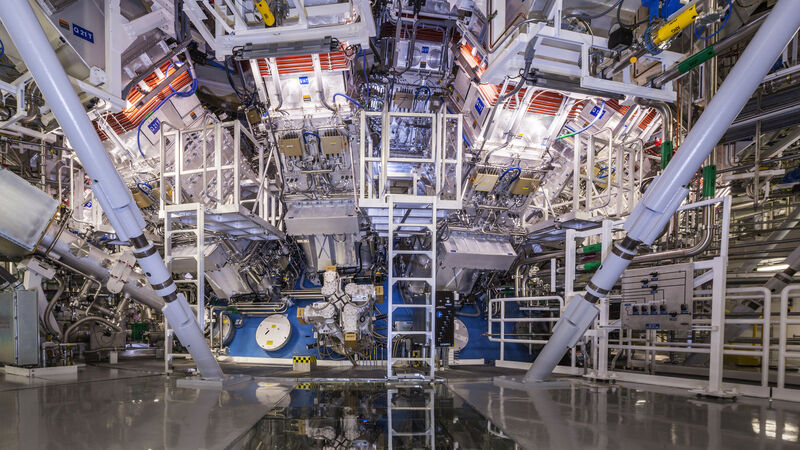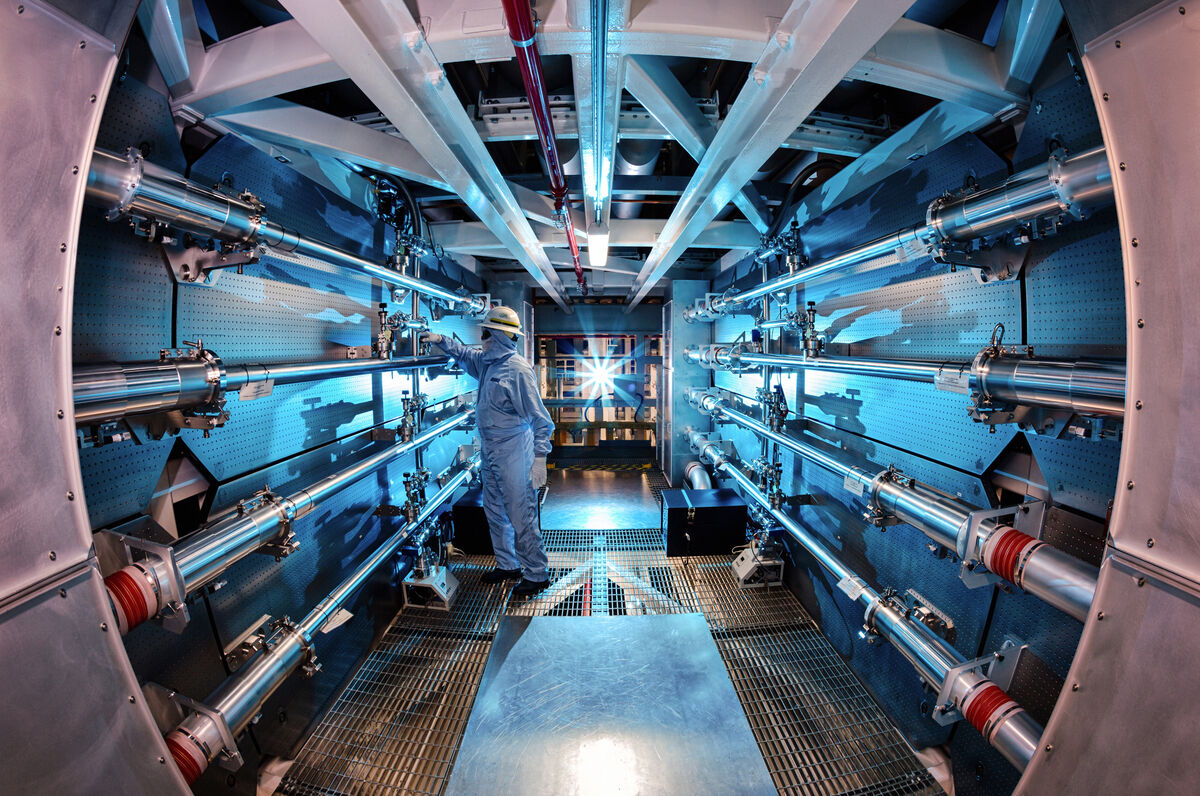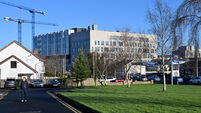Fusion energy: What does the recent breakthrough by scientists in California mean?

The ultimate goal of the research at the National Ignition Facility at the Lawrence Livermore National Laboratory is to construct fusion reactors that would provide electric generation capacity to ensure a stable supply in a post-fossil fuel world where most power will be generated by inherently volatile renewable energy sources. File picture: Damien Jemison/Lawrence Livermore National Laboratory via AP
Nuclear fusion is the process by which hydrogen and other light nuclei fuse together to form a larger daughter nucleus whose mass is slightly less than the sum of the parent nuclei masses. This “missing mass”, M, appears in the form of a large release of kinetic energy, ie energy of motion, via Einstein’s equation E = Mc where c is the speed of light.
Fusion is the energy source that powers all stars, including our Sun, and hence is essential for sustaining life on Earth.
Energy-producing fusion reactions are predicted under very specific conditions on Earth, and since 1958, when earlier defense-related research carried out in the US, the USSR and the UK was declassified, the peaceful use of fusion power has been a long-term research topic in many countries, including Ireland where links with major European laboratories were established from the 1970s onwards, notably by the former Head of Department of Electrical Engineering at UCC, Professor Michael Sexton.
The ultimate goal of this research is to construct fusion reactors that would provide electric generation capacity to ensure a stable supply in a post-fossil fuel world where most power will be generated by inherently volatile renewable energy sources.
The splitting of very heavy nuclei, such as uranium, which is far easier to achieve than fusion, also releases energy, and this is the basis for conventional nuclear fission reactors with their attendant issues of reactor safety and long-lived, highly concentrated radioactive waste products. A fusion reactor, by contrast, would have no similar safety concerns and relatively little waste generation.
The consequences of a loss of control over a fission reactor, as happened at Chernobyl in 1986 and Fukushima in 2011, are disastrous. A loss of control in a fusion reactor, far from leading to meltdown and/or a nuclear explosion, would merely cause the reactions to quench abruptly, with the only consequence being a temporary loss of power generation capacity.
In the quest for fusion-based electric power generation, the most easily achieved fusion reaction, involving two heavy hydrogen isotopes, deuterium (D) and tritium (T), produces no immediate radioactive waste. Most of the fusion energy is carried by energetic neutrons, however, and these induce a low level of radioactivity over time in the surrounding structures, but it is far less concentrated than fission waste products, and decays on far shorter timescales (a hundred years versus many tens of thousands of years).
There are two major lines of research in fusion energy, one involving the use of strong magnetic fields to confine charged hydrogen gas nuclei and freely roaming electrons at extreme temperatures long enough for the nulcei to collide and fuse. This is termed Magnetic Confinement Fusion (MCF) and is considered to be the most likely path to a functioning fusion energy plant.
In the other main line of research, a large number of high-power lasers ‘zap’ a frozen spherical pellet of deuterium and tritium causing the surface layer of the pellet to explosively disintegrate outwards.
The recoil from the surface layer explosion causes the cold interior of the pellet to collapse in on itself, causing its density to rise to hundreds of times that of ordinary matter, and the associated kinetic energy causes the imploding material to reach extreme temperatures of a hundred million degrees celsius.
Under these extreme conditions, fusion reactions occur spontaneously on an extremely short timescale of a picosecond, or one million-millionth of a second. The very brief time it takes for the rapid inward motion of the pellet matter to stop and reverse direction gives this line of research its name: Inertial Confinement Fusion (ICF).
Finally, the enormous mass of the Sun and stars enables fusion energy generation by gravitational confinement, a mechanism which is not available to laboratory researchers.
Since 1958, fusion energy research has focused on trying to demonstrate that a net energy-producing fusion reaction on Earth is possible in practice. Initial results were far from promising, with output fusion energy around 0.01% of input energy.
Advances since then have progressed slowly but steadily, culminating in the achievement of 60% output fusion energy for several seconds in 1997 at the Joint European Torus, the largest operating MCF fusion experiment in the world, which is located outside Oxford and to which a number of Irish scientists and engineers have made significant contributions.
Further progress in achieving ‘break even’, where fusion energy output equals or exceeds the input energy has been slow in the intervening period. That is, until the recent ground-breaking announcement by the National Ignition Facility (NIF) at California’s Lawrence Livermore Laboratory, the globally leading centre for ICF research, that a fusion reaction in the laboratory generated excess fusion energy for the first time.
Slightly over two megajoules (MJ) of energy were absorbed by the pellet (an admittedly small fraction of the 300 MJ required to fire the 192 lasers that were directed into a small, hollow gold cylinder containing the pellet) and more than 3 MJ were detected from the fusion reactions that followed the pellet implosion, so that the fusion reactions generated 50% more energy than was absorbed by the pellet.
From an engineering perspective, the energy efficency was a mere 1% (3 MJ output for 302 MJ input), but this is to miss the true significance of this major scientific breakthrough.

It could be compared to the demonstration of the first electric motor by the great English experimental physicist Michael Faraday in 1821. When asked by a politician “What good is it?”, Faraday reputedly replied “What good is a new-born baby?” (A more cynical version of this anecdote goes “Soon you will be able to tax it”)
Enormous decades-long challenges still face both MCF and ICF research before the prospect of a fusion power plant is realised, if ever. Of the two constituents of the D-T (deuterium-tritium) reaction, deuterium is plentifully available in the form of heavy water which can be easily extracted from sea water.
Tritium, however, is not naturally occurring and must be obtained via transmutation of lithium by capturing the neutrons released in the D-T reaction in a so-called lithium blanket which will surround the reactor. Pertinent experimental tests of this process have yet to be carried out, and it remains to be seen how much lithium-6, the isotope of lithium used for tritium breeding, is available.
Other, more ambitious approaches to fusion energy production include a reaction involving hydrogen and boron which does not emit neutrons, a distinct advantage over D-T. Another plus is that its plentiful reserves in the Earth’s crust are estimated to be sufficient to power the planet for 3,000 years. The caveat is that boronic fusion is much more difficult to achieve than D-T fusion.
In summary, the breakthrough at NIF is a landmark advance in the pursuit of the holy grail of a safe, clean and reliable carbon-free source of power generation. It can’t come soon enough to slow down, and ultimately arrest, the ominous and accelerating rate of climate change caused by carbon emissions that result from the unabated consumption of fossil fuels.
- Dr Pádraig McCárthaigh has been active in fusion energy research in the Department (now School) of Physics, UCC, since the early 1990s and has a long-term involvement with the Max Planck Institute for Plasma Physics in Munich.
CLIMATE & SUSTAINABILITY HUB
















